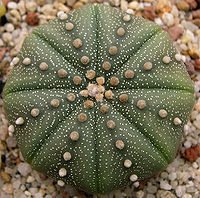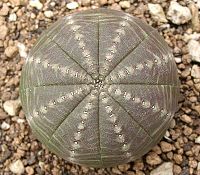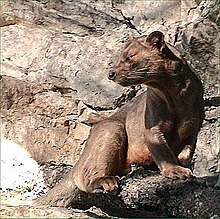Convergent evolution
Convergent evolution is a process in biology. It occurs when two species from different lines develop the same traits or features. This happens because they live in similar habitats, and have to develop solutions to the same kind of problems.[1]



This has evolved in appearance and behaviour to be so like a large cat that it was originally classified in the Felidae, but in fact it is closely related to the mongoose
Similarity in traits can occur in two ways. Both species might have acquired the trait by descent from a common ancestor. In this case the structures are homologous. An example is the tetrapod limb, which has been inherited from early tetrapods in the late Devonian/early Carboniferous, about 360 million years ago. On the other hand, both might be independent adaptations to similar conditions in their habitat. In this case the structures are analogous. Convergent evolution leads to analogous features.
Examples change
- Wings: the wings of insects, birds, bats and pterosaurs are similar to a certain degree. In particular, they are all thin and strong, with a wide surface area. The wings can be mechanically moved in a regular way so as to create lift; and so on. In each case the wings evolved separately, so their form reflects certain physical necessities. The three larger animals all have insulation and temperature regulation, and hence a high rate of metabolism. That is also necessary for flight, which requires a great deal of energy.
- Eyes: One of the most famous examples of convergent evolution is the camera eye of cephalopods (e.g. squid), vertebrates (e.g. mammals) and cnidaria (e.g. box jellies).[2] Their last common ancestor had a simple photoreceptive spot, but there was progressive refinement of its structure to the advanced camera eye.[3] The similarities of such a complex structure shows how there may be some challenges which have an optimal solution.
- Nectar-eaters: Four groups of songbirds from different families in different countries specialise in nectar-eating. They are the hummingbirds (Trochilidae; Americas); the sunbirds (Nectariniidae; South Africa); the honeyeaters (Meliphagidae; Australia); and the honey-creepers (Drepanididae; Hawaii).[4]p224 They have similar adaptations because all of them use their tongue to eat nectar from the center of flowers.
- Vultures of the Old and New Worlds come from separate, though related families. Old World vultures come from the family Accipitridae, which also includes eagles, kites, buzzards, and hawks. Old World vultures find carcasses exclusively by sight. New World vultures belong in the family Cathartidae, and use scent as well as sight. They are both large, soaring birds which are specialist feeders on dead carcasses. They have powerful beaks, long featherless necks, strong stomach acids, an extensive crop to store the food while eating, and so on. These traits have evolved independently.
- The shape of large, fast-moving aquatic animals tends towards a torpedo shape: tuna, sharks, dolphins, killer whales, ichthyosaurs all have a similar shape. This streamlined shape reduces drag as they move through the water. Fins of some (ichthyosaurs, sharks) occur in the same places on the body. They have arrived at this shape from very different starting points.
- The sabretooth cat lifestyle evolved independently at least five times in mammals.
- Small animals which sleep in trees: Many hang on with their feet, in which case they usually have a tendon locking device which keeps them hanging on even during sleep.[5][6][7][8] Once the tendons are locked, the muscles in their legs and feet can relax.[9] Even dead bats stay hanging.[10] These various examples have evolved independently of each other: this is known from the fine details of the mechanism. One plus of a locking mechanism is that it allows attachment to slender branches on which predators might be unable to walk.
Examples of convergent evolution are extremely numerous: it is an important feature of evolution.
Parallelophyly change
Parallelophyly is the special case where two or more lines with a close common ancestor acquire the same character independently. Cichlid fish in Lake Tanganyika in East Africa have developed the same feeding method in six different lines. Stalked eyes occur irregularly and independently in acalypteran flies. They have clearly inherited the genetic capacity for such eyes. This capacity is selected only in some lines.[4]p62, 225
References change
- ↑ "Online Biology Glossary". Archived from the original on 2010-02-01. Retrieved 2008-05-03.
{{cite web}}: CS1 maint: bot: original URL status unknown (link) - ↑ Kozmik Z. et al. 2008. Assembly of the cnidarian camera-type eye from vertebrate-like components. PNAS 105 8989–8993. doi:10.1073/pnas.0800388105. ISSN 0027-8424. PMID 18577593. PMC 2449352. http://www.pnas.org/cgi/pmidlookup?view=long&pmid=18577593.
- ↑ Conway Morris, Simon 2005. Life's solution: inevitable humans in a lonely universe. Cambridge. ISBN 978-0-521-60325-6, OCLC 156902715
- ↑ 4.0 4.1 Mayr, Ernst 200. What evolution is. Weidenfeld & Nicolson, London.
- ↑ Simmons N.B. and Quinn T.H. 1994. Evolution of the digital tendon locking mechanism in bats and dermaptorans: a phylogenetic perspective. Journal of Mammalian Evolution. POI: 10.1007/BF 01464276 [1]
- ↑ Stefoff, Rebecca (2008), The Bird Class, Marshall Cavendish Benchmark
- ↑ Brooke, Michael & Birkhead, Tim 1991. The Cambridge Encyclopedia of Ornithology. Cambridge University Press. ISBN 0521362059
- ↑ It works by one tendon running down the leg shifting position slightly so it grips the tendon which closes the toes. Bats independently evolved a similar arrangement. Quinn T.H. & Baumel J.J. 1990. Chiropteran locking mechanisms: the passive digital lock. J. Morphology. 109, 281–208.
- ↑ Haffner M. 1966. A tendon locking mechanism in two climbing rodents. Journal of Morphology 229, 197–227.
- ↑ Where do bats live? University of Edinburgh Natural History Collection [2] Includes useful diagram